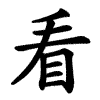看
- to look, to see, to watch, to observe, to guard;
The character expresses the act of seeing with deliberate attention, often implying care, vigilance, or understanding beyond mere sight.
Etymology
Ideogrammatic compound:
手 (손 수) — “hand,” depicting a hand raised to shade the eyes.
目 (눈 목) — “eye,” representing the act of vision.
The combined image shows a hand placed above the eyes, as one does when looking into the distance or examining something closely.
Hence, 看 originally meant “to look attentively” or “to keep watch.”
In bronze and seal script, the pictograph clearly shows a human eye beneath a protecting or shading hand, emphasizing the sense of focus and clarity of perception.
Usage in Korean
감시 (監視) — surveillance, observation
시청 (視聽) — seeing and hearing; media viewing
간찰 (看察) — careful observation or examination
간호 (看護) — nursing, caregiving (lit. “to watch and protect”)
간병 (看病) — caring for the sick
In modern Korean compounds, 看 conveys both watchfulness and care, bridging the ideas of visual attention and protective supervision.
Words that derived from 看
Additional notes
In classical Chinese, 看 signified careful viewing or watching, often with the nuance of discernment — not just physical seeing, but mental perception.
This deeper sense survives in expressions like:
「看破紅塵」 (간파홍진) — “to see through the red dust,” meaning to perceive the vanity of worldly life.
In Buddhist and Daoist contexts, 看 can denote spiritual insight (觀照, seeing with the inner eye).
In Zen Buddhism, phrases such as 「看話禪」 (간화선, “observing the koan”) literally mean “to watch (看) the word (話),” referring to meditative contemplation on a paradoxical phrase.
Thus, 看 carries both literal and metaphysical weight — the act of seeing outwardly and inwardly alike.
Symbolism & usage in literature:
In classical literature, 看 is often used figuratively for perception, understanding, and reflection.
Poets described “看雲” (watching clouds) or “看花” (watching flowers) as acts of quiet contemplation — external scenes serving as mirrors of the heart.
In calligraphy, the instruction “先看後寫” (“First look, then write”) embodies the same principle: seeing is not passive observation, but the moment of comprehension before action.
